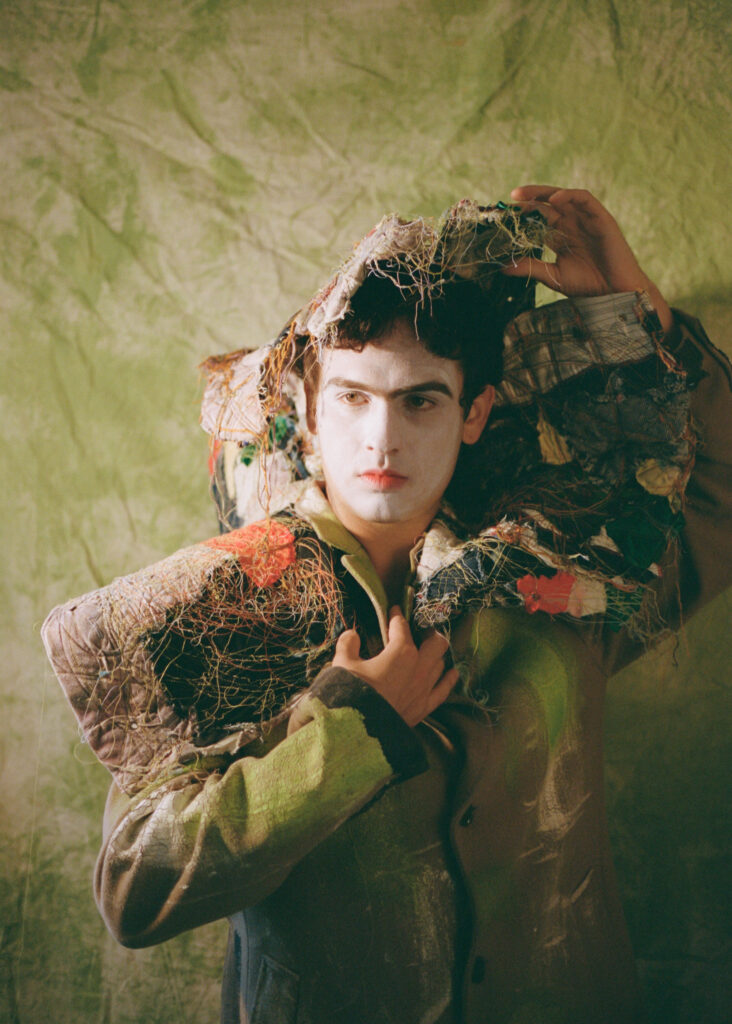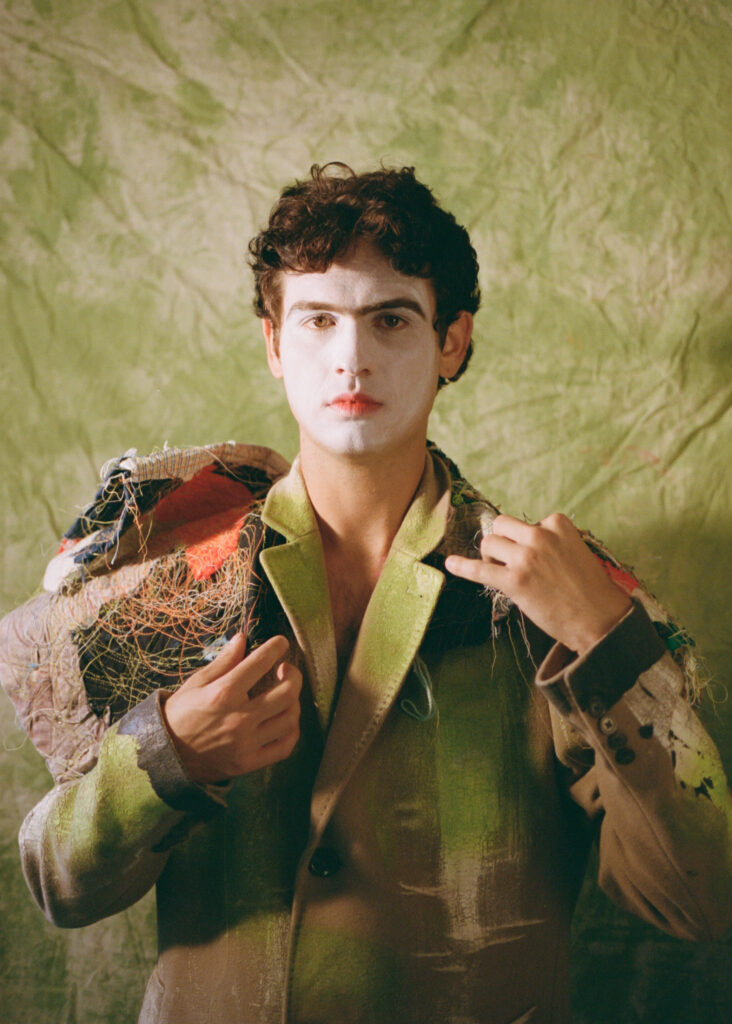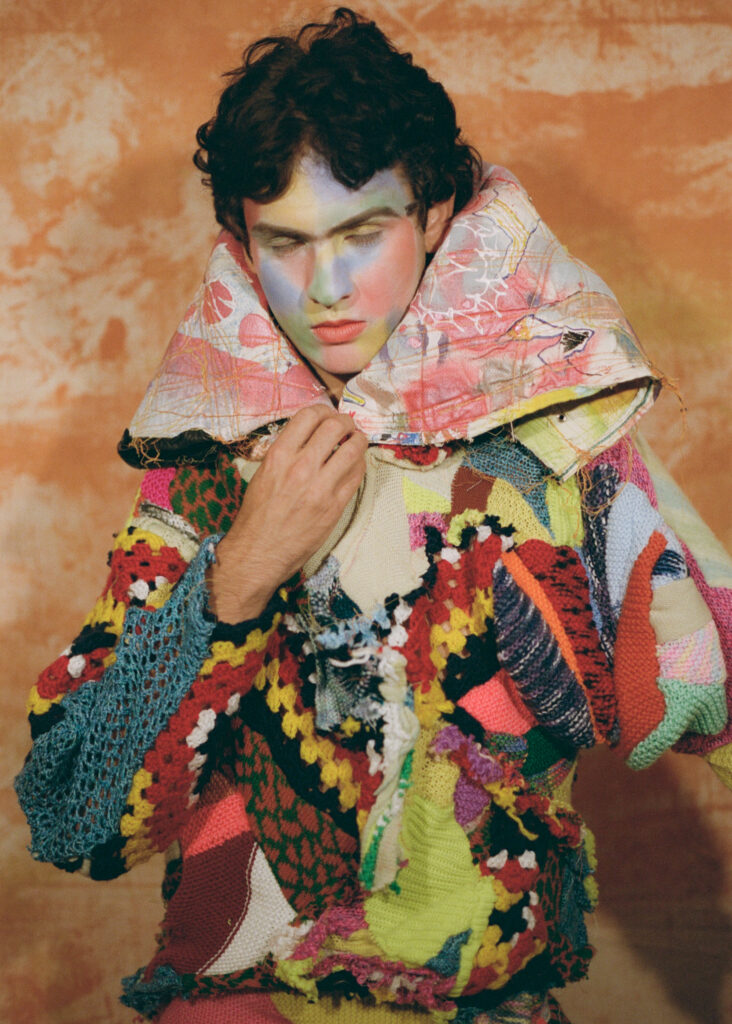Jordan Gogos The Trojan Horse of Design

makeup MINDWELL AMAYA HARVEY HOLCOMB
Jordan Gogos is a multidisciplinary designer based in Sydney, Australia. With a practice that explores the intersection of design and the environment, he is focused on sustainability and supporting the emerging arts sector. If you’re familiar with Jordan’s work, you’ll know chaos is at the core of his creative force. Whether it be in his refined and almost brutalist objects and furniture, or through his wildly colourful clothing label Iορδάνης Spyridon Gogos, his designs are guided by an affinity for disruption, and his vision for a greener future in fashion and design. We spoke with Jordan about creative output, mental health and working alongside Grimes.

Hey Jordan! Run me through what you’ve been up to lately.
Well, a few years ago, I moved into a new apartment and studio, which was very exciting. My last studio was in Redfern and I started the label there in my apartment, but I hadn’t had one since. Before, I had a pop-up table, and I’d sit on my bed and sew. I had absolutely no space—my bathroom was my storage facility! When I would have open houses, there would be three clothing racks and a whole storage unit next to a toilet and you could hardly walk through. And when I had my stuff in Vogue’s September issue in 2021, the editors were coming to my house and my clothes were literally lying on my bed—they would pick them up off my bed and kitchen bench!
There’s a lot of elements that come with being a designer.
Yeah! And it’s not like you’re just making the clothes; you actually have shoots, lookbooks, line sheets, your campaign images …!
It’s almost like making and creating is actually the cherry on top.
Yeah! Even for Fashion Week, you have different criteria that make you relevant, like your database, your social media following, your website stats, and reference letters from people in the industry who will write about you. There are so many things! Like even having a tax agent! [Laughs] Your whole life becomes your work!
Also, no one really teaches you this!
You learn as you go. And as you’re learning, you’re also spending. You’re buying things with the money you’ve made. I’ve reached a point where I’m now represented by an agency with a set design, and I’m stocking with a store, which is great, but it’s still a balancing act.
Yeah, I feel like to make it work, you need both passion and drive.
Yes. Absolutely. It’s really interesting. There’re people who compliment me for my work, and then there’s another side where I get complimented on my energy.
Which brings me to your New York experience! I remember you saying that your work there was really inspired by the energy and the lights in Times Square?
So here’s a little story behind that. I was with my friends Jordan Drysdale, Helena Dong and James Robinson, and we all went to this talk, and it was about eye and colour psychology. The lecturer said that colours are like rebounds, providing information to our brain. And then I started thinking about my New York work, and how crazy the colours were. Before I was doing my clothing, I was only doing my GOGOS objects, which are single-component aluminium.
I had never made any clothing, aside from small iterations of textile art. When I went to Parsons, I was doing a denim class and my teacher was Gerlan Marcel (of Gerlan Jeans) and the whole class was sponsored by Calik Denim. When I was there, I experimented with all these clashes of colour and chaotic combinations of things. Then, when we went to the lecture that I mentioned before, I was like, Wait, this makes total sense. I would walk through Times Square every night and the lights would be flashing, then I would go home and make my clothes or paint stuff, and it was a replication of what I was seeing! But it was completely subconscious.
It’s always so interesting to think about where ideas filter in.
I know we like bracketing ideas, but I also find that reaching out to other creatives can be a source of inspiration. There was this one person who messaged me randomly with this idea about magic tricks, particularly the magic trick where you get cut in half! I thought it was so interesting because they were showing me their ideas and what inspired them, and in turn, that exchange inspired me to apply a sort of ‘circus freak’ mood to my collection. My brand is a Trojan horse. I want to break through the industry, collaborate with people who aren’t designers and include them in the fashion industry.
That’s a huge focus for me this year. I think of my brand, Iορδάνης Spyridon Gogos, as a space for people to work in. I want to collaborate with people from non-fashion backgrounds because for many years, I was outside of the fashion industry, and I found it quite exclusionary. I want people to work with my brand, create a collection with it, or make a piece that can be shot in editorials. I want people to feel like they can say something through fashion, even if they haven’t had that background.
The Trojan horse of fashion!
The Trojan horse symbol actually started as a joke because I said to myself, “I want to make the craziest pieces and I’ll just hope they’ll be in Vogue!” COVID-19 really changed the industry – even in March [2020], there already wasn’t much happening. And I was like … If I just sit in my house making, people will start noticing it and seeing it! Then the next minute, I had a chance to work with Vogue. You know, you have to sort of mock the industry otherwise it’s too overwhelming. I felt like I was going to break through the boundaries. When has someone ever gone from painting on their bathroom floor to the pages of Vogue in three months? And I was posting it all on my Instagram, too!
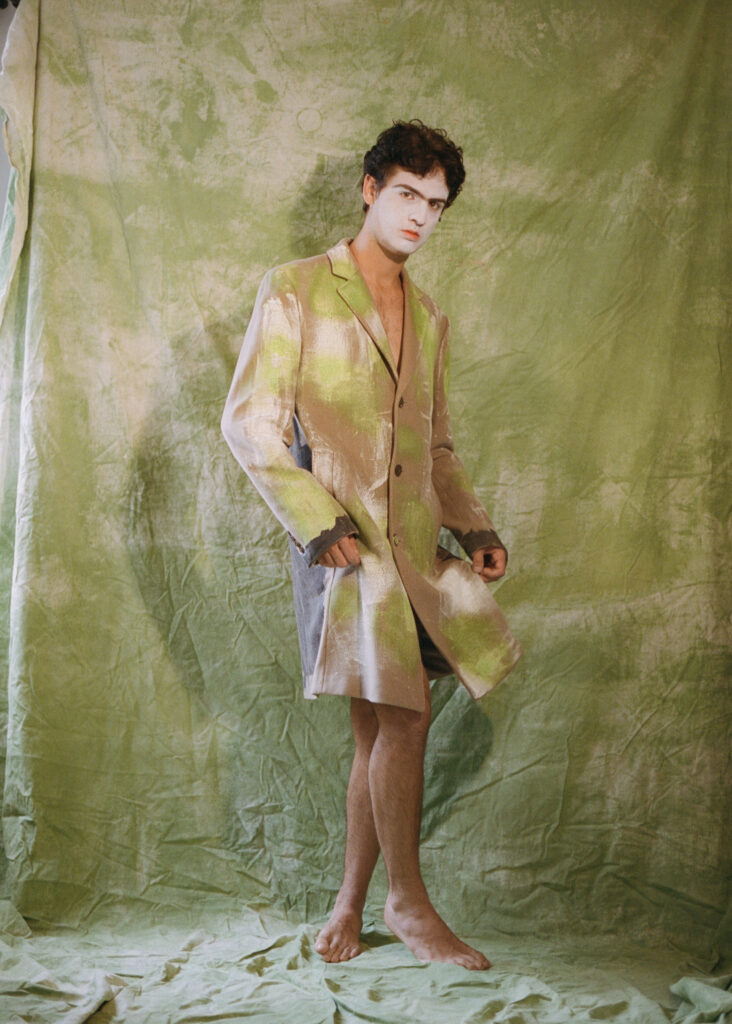
The power of social media! Have you ever reached out to anyone on Instagram on a whim?
Ha, well look. Once I did reach out to Grimes over DM and she never responded so … But then I ended up working with her!
Wait, so what was working with Grimes like!?
I did Bio-Haque, which was Grimes’ Art Basel Miami event. I was staying with Sophie and Signe Pierce. It was such an amazing and creative little household. We developed this structure that was based on this idea that the artist doesn’t have authorship over their work, so the artist doesn’t get to choose what governs their work. And we applied this concept to stage, and performing. So they [the production team] wanted a table to take on tour that was collapsible, height adjustable, round and could be rotated, so when the artists were performing they could control the way they collaborated with us on stage. The project was (and still is) a work in progress.
So how did you get the opportunity to be looped into this job?
I actually just got contacted through Instagram! They said they had Nina Kraviz, Grimes and Sophie doing Art Basel Miami, with Sophie as the creative director, and they said they would fly me over, and that they had an apartment where we were going to be making stuff. And that was that!
Sounds like an incredible experience.
But honestly, the best experience was meeting Signe Pierce because she is an amazing artist. One thing she kept saying was, “In order for real change to occur, you need to keep in mind the following things: intention leads to direction, direction leads to action, action leads to change.” We talked about cycles in life and how every single thing we do is a cycle. Whether it be the food we’re eating, our processes, our love life – each thing that we do is a repetition. In order for real change to happen – not just altering your state of being, but real change – the cycle that you identify with needs to be obliterated. Not just altered – you completely need to eradicate that thing in your life in order to make a real impact. Honestly, these concepts and these ideas that we were discussing together were life-changing for me.
That’s an interesting way of approaching the creative process. You really do need to reset and restart in order to make space for something equally as powerful.
Yeah, and what is the impact of that?
You know, if you say you’re not going to work with any huge corporations, how is that going to change the way that you’re working? I think that is the real impact. Completely going against what is built up in order to reach success.
What are your personal goals?
In terms of work, I’m thinking couture. I just really love the idea of couture because I have been trying to find the balance between making articles of clothing for other people to enjoy and making clothes for myself as an artist to enjoy. It’s like, if you go commercial and people love wearing your brand, you still have to ask yourself if you’re enjoying it. For me, I need to enjoy it just as much.
To explain: with couture, where it’s a slow process and it’s about the embellishments and the details in the pieces that I’m making, even if I make only 10 pieces this entire year, I want to have a level of decadence that I’ve never achieved before. I think I will really enjoy that. I need to love what I’m making too.
Fantastic summary!
I do also think that’s a sustainable approach. It’s about avoiding overproduction. I want to really enjoy the garments, not completely oversaturate the market! The thing is that these companies keep saying, “We’ll reach these targets by 2030!” We need to reach them in the next two weeks! I really do wonder sometimes about being a small-scale designer. Unpacking this idea, I feel like my yearly waste wouldn’t equal even one of a big fashion conglomerates’ single T-shirts. From their bleaching process, to the exploitation of wages and people. Then I wonder if I can engage in a conscious practice. I think small designers are way too focused on finding sustainable practices, rather than looking at the big guys. One year’s worth of my scraps and fabric offcuts could fit into a single cardboard box. Even if I turned to mass producing t-shirts and I made x amount, I feel like the impact of doing that wouldn’t equal even 0.000001% of a fast fashion giant’s environmental impact. I think in order to be sustainable, we need to actually be scrutinising the big guys rather than the small guys. Smaller voices and sustainable messages should be projected to influence large-scale businesses, because our impact collectively as small designers isn’t even a fraction of what these big companies are doing.
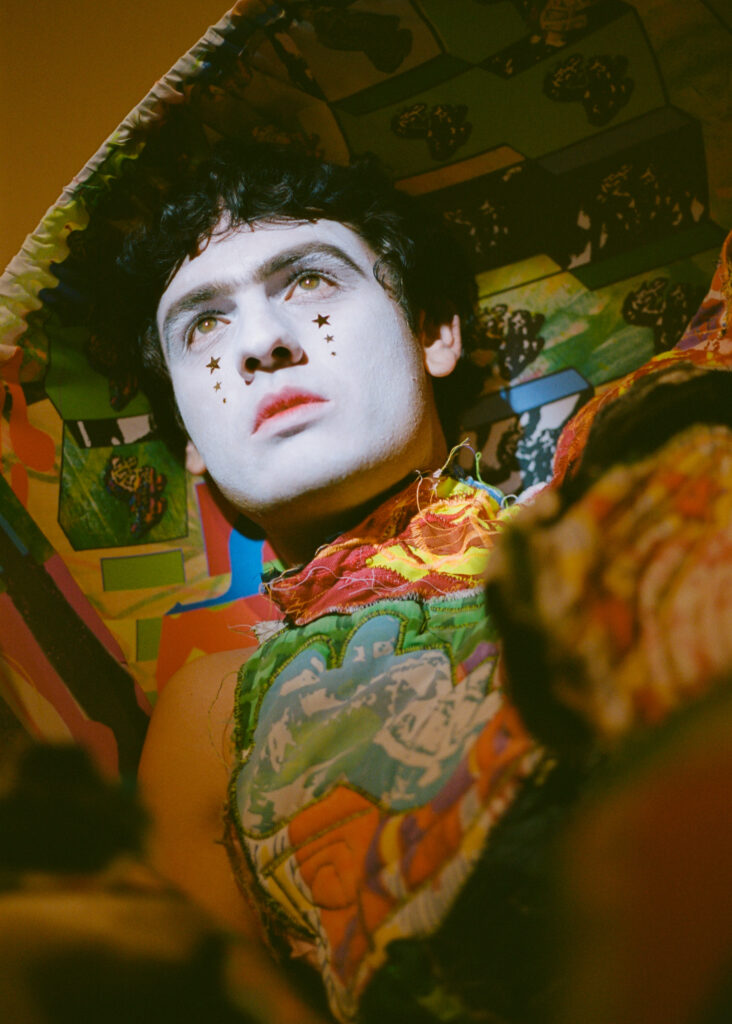
Do you think that supply and demand come into play with these big corporations?
I feel like our generation is looking to not support those big conglomerates. I’m finding that a lot of the conversations I’m having are shifting towards supporting small business and localised art and design. I’m not trying to be the most sustainable designer ever. But when people look at and touch my work, they’re realising that in the production of these pieces, waste was considered beforehand. I don’t want to be looked at as the matriarch of sustainability, because I’m definitely not. Even painting involves things like plastic bottles, thread has plastic around it and in the middle of it, etc. But people are thinking more about this stuff so it becomes a reflective practice. You’re wearing and acknowledging a desire for change. Someone will wear something, then tell five other people and then out of those five people, someone looks into it more, so that discussion has a domino effect.
There are so many structures in place that are heavily ingrained in our industries and infrastructure so it’s going to take a huge, unified effort to truly change.
That’s right. And we also need transparency, that’s the staple to any industry! Being transparent allows people to criticise your practice and keeps you more responsible.
That’s actually another part I love about your work. You share your process and constantly engage your community, and they engage with you.
It has really encouraged people to make. I’ve had messages from people saying, “Seeing you trying, doing things, made me do this,” and I’ve seen so many people doing their own thing! It wasn’t thousands of people, but there were enough who realised that they really didn’t need a studio to make work! I think people saw me making out of my bathroom for months!
Was that your little brother in videos modelling for you?
Yes! And that’s the point of the brand. It doesn’t matter if a 5-year-old is wearing it or whoever, it’s about the narrative that the brand carries with it, which has a chaotic cohesiveness about it! I want it to be as inclusive as possible, anyone can engage with my work. It’s not meant to be like, “Only Jordan can do that.” I want people to be able to come into my studio and just throw themselves into a piece and let go of any constraints!
one-off pieces by IORDANES SPYRIDON GOGOS
Elena Velez Creates Under Constraint
By Katie Brown
Acne Studios Melbourne Little Bourke Store Reinvents Itself with Expansive Transformation
By T.
Australian Fashion Week Wrap
By Briony Wright
Saint Laurent Women’s 2024 Show
By Katie Brown
Reveries Tells The Story Of Priya Ahluwalia’s Folkloric Beginnings
By Poppy Oliver
Alasdair McLellan: What You See is What You Get
By Sarah Buckley
